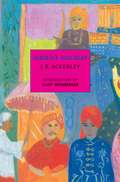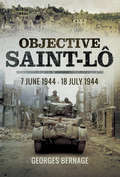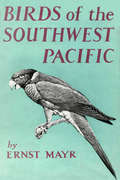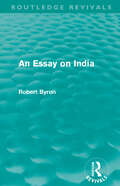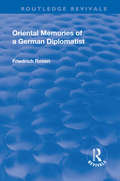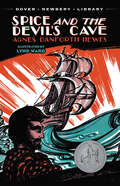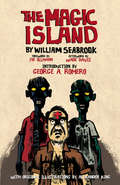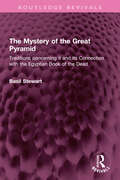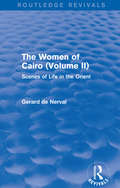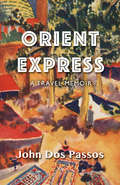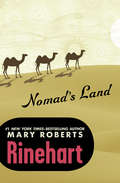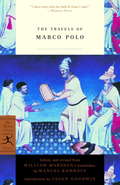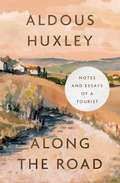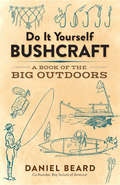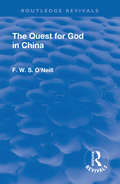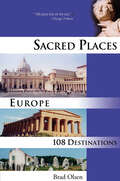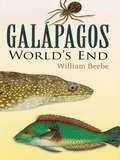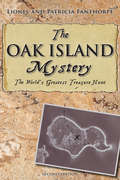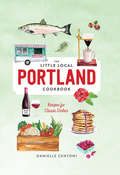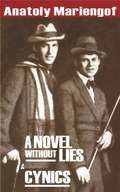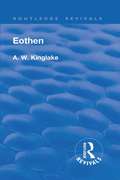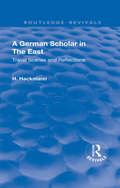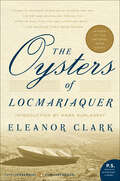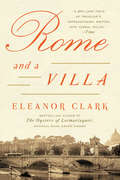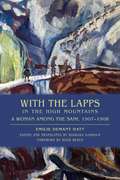- Table View
- List View
Hindoo Holiday
by J. R. Ackerley Eliot WeinbergerIn the 1920s, the young J. R. Ackerley spent several months in India as the personal secretary to the maharajah of a small Indian principality. In his journals, Ackerley recorded the Maharajah's fantastically eccentric habits and riddling conversations, and the odd shambling day-to-day life of his court. Hindoo Holiday is an intimate and very funny account of an exceedingly strange place, and one of the masterpieces of twentieth-century travel literature.
Objective Saint-Lô: 7 June 1944–18 July 1944
by Georges Bernage&“A collection of eyewitness accounts of the heavy fighting that took place in this part of France after the Omaha landings . . . excellent and gripping.&”—FSAddon This book provides a day-by-day account of the forty-two days of fighting from Omaha Beach to Saint-Lô. Follow Lt. Allsup from the beaches at Hill 108 (the &“bloody hill&”), where he was injured, and Lt. Jones, who was among the first to enter Saint-Lô; a town destroyed by bombs, which was to become the graveyard of hundreds of Normans. On the opposing side, discover the fate of the fearsome &“green devil&” paratroopers of General Schimpf and follow in the footsteps of paratroopers Erwin Schmieger and Rudi Frühbeisser, as they defend their armed camp, ensuring that every hedge will only be taken at the highest price. Objective Saint-Lô takes the reader along the little or unknown routes from the horrors of Omaha Beach to Trvires, La Cambe, Isigny, through the Aure valley to Hill 108, (&“Purple Heart Hill&”) and Hills 192 and 122. As well as authentic eyewitness testimony, the book also acts as a field guide, including maps and both contemporary and modern photographs. &“Lavishly illustrated with sketch maps, then and now images and numerous personal accounts from US and German sources, this is an excellent campaign overview, ideal for tour planning.&”—Guild of Battlefield Guides &“An exciting story with insights from those who were there and an amazing collection of photographs, drawing and maps—Highly Recommended.&”—Firetrench
Birds of the Southwest Pacific
by Ernst MayrThis is the only book in the English language on the birds of the wide area between Fiji, New Caledonia and Micronesia. This practical handbook, by an acknowledged authority, intended primarily for the field student, tells him how to identify and name the birds which he encounters, and what kinds of birds he can expect to find on each island. There is also a condensed summary of the presentknowledge of distribution, geographical variation and habits. Whenever feasible, keys have been supplied to facilitate identification. These keys are simplyand clearly worked out for the beginner who may not know the difference between a curlew and a godwit, or a triller and a graybird.Three magnificent color plates show 39 species which include at least one representation of all of the prominent bird families of the southwest Pacific.A series of black and white drawings show additional species. These pictureswill be particularly valuable to bird students who have never seen awood swallow, a flower pecker, a white-eye or a triller.
An Essay on India (Routledge Revivals)
by Robert ByronFirst published in 1931, Robert Byron’s Essay on India evaluates the state of colonial rule in India and analyses the contemporary problems facing the country. Based upon Byron’s travelling experiences within India in 1929 as a correspondent for the Daily Express, the work explores political factors more fully than in Byron's earlier writings, evaluating the successes and failures of British colonialism in the region.
Revival: Oriental Memories of a German Diplomatist (Routledge Revivals)
by Friedrich RosenHis Excellency Dr. Friedrich Rosen, the well known German Diplomatist and Orientalist, has written a fascinating account of his manifold experiences in the Near East, including Palestine, Syria, Persia and Mesopotamia, during a period of forty years. Many politically important or otherwise interesting mean and women, such as Ex-Emperor William II, Prince Bulow, Baron von Holstein, Sir Frank Lascelles, Sir Valentine Chirol, Lord Curzon and Miss Gertrude Bell, are spoken of in this volume.
Spice and the Devil's Cave
by Agnes Danforth HewesFerdinand Magellan, Vasco da Gama, and other fifteenth-century adventurers spring to life in this thrilling tale of the competition between Portugal and the Venetian Republic to discover an all-sea trade route leading to the spices of India. In the Lisbon workshop of banker and navigation enthusiast Abel Zakuto, a group of intrepid explorers gather to discuss the possibility of finding a way around the stormy tip of Africa — the Devil's Cave. Author Agnes Danforth Hewes won the first of her three Newbery Honor awards with this book, which was praised by The New York Times as "one of those engrossing works of historical fiction whose appeal is nearly universal . . . a colorful history of a far-reaching commercial struggle and a vivid drama of individual hopes and aspirations." Enchanting woodcuts by Lynd Ward illustrate this gripping adventure, which is suitable for grades 7 and up and will delight readers of all ages.
The Magic Island
by William Seabrook George A. Romero Joe Ollmann Alexander King"The best and most thrilling book of exploration that we have ever read ... [an] immensely important book." -- New York Evening Post"A series of excellent stories about one of the most interesting corners of the American world, told by a keen and sensitive person who knows how to write." -- American Journal of Sociology"It can be said of many travelers that they have traveled widely. Of Mr. Seabrook a much finer thing may be said -- he has traveled deeply." -- The New York Times Book ReviewThis fascinating book, first published in 1929, offers firsthand accounts of Haitian voodoo and witchcraft rituals. Journalist and adventurer William Seabrook introduced the concept of the walking dead - zombies - to the West with his illustrated travelogue. He relates his experiences with the voodoo priestess who initiated him into the religion's rituals, from soul transference to resurrection. In addition to twenty evocative line drawings by Alexander King, this edition features a new Foreword by cartoonist and graphic novelist Joe Ollmann, a new Introduction by George A. Romero, legendary director of Night of the Living Dead, and a new Afterword by Wade Davis, Explorer in Residence at the National Geographic Society.
The Mystery of the Great Pyramid: Traditions concerning it and its Connection with the Egyptian Book of the Dead (Routledge Revivals)
by Basil StewartFirst published in 1929, The Mystery of the Great Pyramid attempts to unravel the secrets of the Great Pyramid by drawing parallels with the rituals in the Book of the Dead. The conception of the Pyramid and the origin of the cult of Osiris and of the Book of the Dead are to be found in a common source, which maybe expressed in the one word, Messianism. The author argues that this is why the literature of early Christian gnosticism abounds in mystical pyramid figures and associated astronomical conceptions and constellations. This book will be of interest to students of history, philosophy, and theology.
The Women of Cairo: Scenes of Life in the Orient (Routledge Revivals)
by Gerard De NervalThe Women of Cairo: Scenes of Life in the Orient, first published in 1929, describes the trip to Egypt and other locations in the Ottoman Empire taken by French Romanticist Gerard de Nerval. The book focuses on both reinforcing and dispelling the old ways in which people saw the Orient, as well as examining their old and new customs. This book is perfect for those studying history and travel.
Orient Express
by John Dos PassosBefore John Dos Passos enjoys fame as a chronicler and critic of American society, he wins recognition for command of aesthetics. Orient Express, a memoir of the author's travels through Eastern Europe, the Near East, and the Middle East, focuses on sights, sounds, and smells rather than plot or character. Dos Passos applies his instincts as a painter to mountain ranges and grimy alleyways, finding beauty everywhere. His tour extends from Tiflis, Georgia, to Erivan, Armenia, and Marrakesh, Morocco; from Kasvin, Iran, to Baghdad, Iraq, and Damascus, Syria. He crosses the Syrian Desert, observes the aftermath of the Greek-Turkish War, climbs the Caucasus, explores Persia during the rise of Reza Kahn, and records the creation of Iraq by the British. His message is clear and relevant to contemporary travelers: holiness and happiness abounds in the East as much as the West. "With the name of Allah for all baggage," Dos Passos writes, "you could travel from the Great Wall of China to the Niger and be fairly sure of food, and often of money, if only you were ready to touch your forehead in the dust five times a day and put away self and the glamorous West. And yet," he adds, "the West is conquering."
Nomad's Land
by Mary Roberts RinehartA memoir of desert travel—by camel and horseback—from a beloved authorAn internationally renowned writer of mystery fiction, Mary Roberts Rinehart knows her way around an exotic setting. When faced with the Pyramids, the Nile, and the sprawling Egyptian desert in her own life, she does not fall in with the crowd of tourists waiting in line at the tombs of the Pharaohs. Instead, she hikes up her skirt, plants her pumps in the sand, and hops on a camel. She has but one question: Where am I supposed to sit?On a hundred-mile expedition into the Egyptian desert, Rinehart does her best to master the herky-jerk of this desert beast. But traveling with an entourage of well-mannered people, she finds that desert living is not completely stripped of the comforts of home. Upon returning to the United States, Rinehart makes an excursion out west, which, she finds, is where the true adventure begins.
The Travels of Marco Polo
by Manuel Komroff William Marsden Marco Polo Jason GoodwinMarco Polo's account of his journey throughout the East in the thirteenth century was one of the earliest European travel narratives, and it remains the most important. The merchant-traveler from Venice, the first to cross the entire continent of Asia, provided us with accurate descriptions of life in China, Tibet, India, and a hundred other lands, and recorded customs, natural history, strange sights, historical legends, and much more. From the dazzling courts of Kublai Khan to the perilous deserts of Persia, no book contains a richer magazine of marvels than the Travels.This edition, selected and edited by the great scholar Manuel Komroff, also features the classic and stylistically brilliant Marsden translation, revised and corrected, as well as Komroff's Introduction to the 1926 edition.
Along the Road: Notes and Essays of a Tourist (Paladin Bks.)
by Aldous HuxleyWitty and &“enchanting&” reflections on the experience of travel, with a focus on art, music, and literature, by the author of Brave New World (The Spectator). One of the most renowned and prolific writers of the twentieth century, Aldous Huxley produced not only dystopian fiction like Brave New World and philosophical memoirs like The Doors of Perception, but also insightful travel writing. Here, he discusses his visits to Italy, France, and other European destinations; reflects on cultural landmarks; and ruminates on the benefits and challenges of travel itself, offering a fascinating glimpse into the Europe of a century ago—and the mind of a remarkable author. &“As opposed to those who believe that the best picture is the most famous or expensive one, or the one that wins a prize, Huxley speaks for those prepared to spend contemplative time with works of art.&” —The Sydney Morning Herald
Do It Yourself Bushcraft: A Book of the Big Outdoors
by Daniel BeardBoy Scouts co-founder and avid outdoorsman "Uncle Dan" Beard provides a clear, enthusiastic introduction to the joys of camping, trapping, and outdoor survival. Originally published nearly a century ago, this engagingly written and charmingly illustrated guide provides an atmospheric reminder of a simpler time. Filled with timeless wisdom on conversing with nature, the book also constitutes a source of practical tips, offering advice on fishing, canoeing, and other aspects of outdoor life. Fishing-related instruction includes information on how to catch minnows, how to make a dip net, fly fishing, bait casting, and much more. Readers can learn how to stalk, to photograph, and even to capture wild animals with their bare hands. They'll also discover how to build a canvas canoe and a dugout canoe, how to make a portage, how to handle a canoe, how to row a boat, and the names of all the parts of boats. This ageless volume will prove a helpful companion to hunters, fishermen, campers, backpackers, Scouts, and anyone who enjoys outdoor recreation and the thrill of bushcraft.
Revival: The Quest for God in China (Routledge Revivals)
by F. W. O'Neill,Those who are determined to find the beliefs of other people altogether wrong are recommended not to read this book. No one indeed would care openly to avow such a determination. At the same time, there are very few of us who are able to preserve an unwavering attitude of trust in all assorts of conditions of men. Especially is this the case when our humankind is separated into parties, nations, and religions, labelled with names to some of which in differing ways we have been accustomed to attach associations of dislike. This book discusses Buddhism, Taoism, Confucianism, and Mohammedanism to educate the public as well as theological students.
Sacred Places Europe: 108 Destinations (Sacred Places: 108 Destinations series)
by Brad OlsenCombining current trends, academic theories, and historical insights, this travel guide brings both lesser-known and famous European spiritual locales into perspective by explaining the significance of each sacred site. The cultural relevance, history, and spirituality of each site--including Stonehenge, the Acropolis, Mont Saint Michel, Pompeii, and Saint Peter's Basilica--are explained, creating a moving and artistic travel experience. Each destination--with selections spanning more than 15 countries throughout Europe--is accompanied by easy-to-follow maps and directions.
Galapagos: World's End
by William Beebe"Galápagos is a glorious book. It is high romance, exact science, fascinating history, wild adventure."--NationThe Galápagos Islands are famed for their remarkable wildlife, including land and marine iguanas, land tortoises, four-eyed fish, and flightless cormorants and albatross. In 1835, Charles Darwin observed variations among the islands' species that inspired him to formulate the theory of natural selection. Eighty-eight years later, in 1923, a scientific expedition sponsored by the New York Zoological Society followed in Darwin's wake. Led by renowned biologist and explorer William Beebe, the scientists visited the the islands to study and obtain specimens of indigenous plants and animals. This is Beebe's personal account of that fascinating expedition.Combining rare literary skill with careful research, Beebe produced an exceptionally readable volume, replete with youthful enthusiasm, a romantic's awe before the mysteries of nature, and a scientist's passion for accurate description. He recounts the expedition's enormously productive results, including specimens of 60 species previously unknown to science, and an unparalleled accumulation of data that stimulated many scientific papers and new avenues of naturalistic inquiry. Beebe's account is enhanced with more than 100 splendid illustrations, selected from hundreds of paintings, drawings, and photographs by expedition members. A classic of popular science, it is scientifically rigorous as well as exciting and accessible.
The Oak Island Mystery: The Secret of the World's Greatest Treasure Hunt
by Lionel Fanthorpe Patricia FanthorpeThe Oak Island mystery has been the world’s greatest and strangest treasure hunt, and after years of research the authors have finally solved the sinister with an answer that is challenging, controversial, and disturbing. In 1795 three boys discovered the top of an ancient shaft on uninhabited Oak Island in Mahone Bay, Nova Scotia. The boys began to dig, and what they uncovered started the world’s greatest and strangest treasure hunt but nobody knows what the treasure is. Two hundred years of courage, back-breaking effort, ingenuity, and engineering skills have failed to retrieve what is concealed there. Theories of what the treasure could be include Captain Kidd’s bloodstained pirate gold, an army payroll left by the French or British military engineers, priceless ancient manuscripts, the body of an Arif or other religious refugee leader, or the lost treasure of the Templars. The Oak Island curse prophesies that the treasure will not be found until seven men are dead and the last oak has fallen. That last oak has already gone, and six treasure hunters have been killed. After years of research, the authors have finally solved the sinister riddle of Oak Island, but their answer is challenging, controversial, and disturbing. Something beyond price still lies waiting in the labyrinth.
Little Local Portland Cookbook
by Danielle Centoni30 classic Portland recipes to treasure The Little Local Portland Cookbook brings the essential flavors of Portland, Oregon, to your table. From special coffee drinks and brunch dishes like Huckleberry Hotcakes and Salmon Hash, to delicious Oregon Bay shrimp cocktail, skirt steak with pinot sauce, and Dungeness crab cippino, you’ll find recipes for iconic Portland dishes for every meal. Written by a regional food expert and beautifully illustrated, this little cookbook is the perfect souvenir.
Novel Without Lies & Cynics
by Anatoly Mariengof"Exaltation, hope, despair and a passion for a transfigured future combined with savage humor and intoxicated imagery."--The Times Literary Supplement The turbulent life of a great poet against the flamboyant background of 1920s Bohemian Moscow. With its lively style and psychological insight, this memoir about Sergei Esenin has abiding value for scholar and general reader alike.
Revival: Eothen (Routledge Revivals)
by Alexander William Kinglake Henry Romilly Fedden1948 edition of this popular work, first published in 1844. It presents an entertaining account of the author's Eastern travels. Ostensibly with a view to providing a suggested outline of a tour to the interested reader, the book's portrayal of the internal journey one takes when travelling is as important an aspect of the book's value as is the historical interest it provides.
Revival: Travel Scenes and Reflections (Routledge Revivals)
by Heinrich HackmannIn 1910., Dr Hackmann started on a lengthy tour throughout Mongolia, China, Japan, Cambodia, Siam, and India, studying Buddhism and other Eastern Religions, Shintoism and Taoism. He returned to London in the spring of 1911, and published this book.
The Oysters of Locmariaquer
by Eleanor ClarkWinner of the National Book Award“What an elegant book this is, starting with that most elegant of creatures, the Belon oyster. . . . [Clark’s] fantastic blending of science and art, history and journalism, brings the appetite back for life and literature both.” — Los Angeles Times Book ReviewOn the northwest coast of France, just around the corner from the English Channel, is the little town of Locmariaquer (pronounced "loc-maria-care"). The inhabitants of this town have a special relationship to the world, for it is their efforts that maintain the supply of the famous Belon oysters, called les plates ("the flat ones"). A vivid account of the cultivation of Belon oysters and an excursion into the myths, legends, and rich, vibrant history of Brittany and its extraordinary people, The Oysters of Locmariaquer is also an unforgettable journey to the heart of a fascinating culture and the enthralling, accumulating drama of a unique devotion.
Rome and a Villa
by Eleanor ClarkIn 1947 a young american woman named Eleanor Clark went to Rome on a Guggenheim fellowship to write a novel. But Rome had its way with her, the novel was abandoned, and what followed was not a novel but a series of sketches of Roman life, most written between 1948 and 1951. This new edition of her now classic book includes an evocative foreword by the eminent translator William Weaver, who was a close friend of the author's and often wandered the city with her during the years she was working on Rome and a Villa.Once in Rome, the foreign writer or artist, over the course of weeks, months, or years, begins to lose ambition, to lose a sense of urgency, to lose even a sense of self. What once seemed all-consuming is swallowed up by Rome&$8212;by the pace of life; by the fatalism of the Roman people, to whom everything and nothing matters; by the sheer historic weight and scale of the place. Rome is life itself--messy, random, anarchic, comical one moment, tragic the next, and above all, seductive.Clark pays special attention to Roman art and architecture. In the book's midsection she looks at Hadrian's Villa--an enormous, unfinished palace--as a metaphor for the city itself: decaying, imperial, shabby, but capable of inducing an overwhelming dreaminess in its visitors. The book's final chapter, written for an updated edition in 1974, is a lovely portrait of the so-called Protestant cemetery where Keats, Shelley, and other foreign notables are buried.
With the Lapps in the High Mountains
by Emilie Demant HattWith the Lapps in the High Mountains is an entrancing true account, a classic of travel literature, and a work that deserves wider recognition as an early contribution to ethnographic writing. Published in 1913 and available here in its first English translation, it is the narrative of Emilie Demant Hatts nine-month stay in the tent of a Sami family in northern Sweden in 1907 8 and her participation in a dramatic reindeer migration over snow-packed mountains to Norway with another Sami community in 1908. A single woman in her thirties, Demant Hatt immersed herself in the Sami language and culture. She writes vividly of daily life, womens work, childrens play, and the care of reindeer herds in Lapland a century ago. While still an art student in Copenhagen in 1904, Demant Hatt had taken a vacation trip to northern Sweden, where she chanced to meet Sami wolf hunter Johan Turi. His dream of writing a book about his people sparked her interest in the culture, and she began to study the Sami language at the University of Copenhagen. Though not formally trained as an ethnographer, she had an eye for detail. The journals, photographs, sketches, and paintings she made during her travels with the Sami enriched her eventual book, and in With the Lapps in the High Mountains she memorably portrays people, dogs, reindeer, and the beauty of the landscape above the Arctic Circle. This English-language edition also includes photographs by Demant Hatt, an introduction by translator Barbara Sjoholm, and a foreword by Hugh Beach, author of A Year in Lapland: Guest of the Reindeer Herders.
